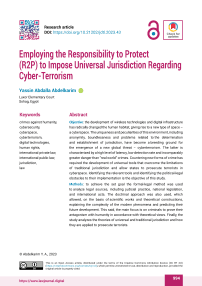Employing the Responsibility to Protect (R2P) to Impose Universal Jurisdiction Regarding Cyber-Terrorism
Автор: Abdelkarim Y. A.
Журнал: Journal of Digital Technologies and Law @lawjournal-digital
Статья в выпуске: 1 (4), 2023 года.
Бесплатный доступ
Objective: the development of wireless technologies and digital infrastructure has radically changed the human habitat, giving rise to a new type of space – a cyberspace. The uniqueness and peculiarities of this environment, including anonymity, boundlessness and problems related to the determination and establishment of jurisdiction, have become a breeding ground for the emergence of a new global threat – cyberterrorism. The latter is characterized by a high level of latency, low detection rate and incomparably greater danger than “real world” crimes. Countering new forms of crime has required the development of universal tools that overcome the limitations of traditional jurisdiction and allow states to prosecute terrorists in cyberspace. Identifying the relevant tools and identifying the political-legal obstacles to their implementation is the objective of this study. Methods: to achieve the set goal the formal-legal method was used to analyze legal sources, including judicial practice, national legislation, and international acts. The doctrinal approach was also used, which allowed, on the basis of scientific works and theoretical constructions, explaining the complexity of the modern phenomena and predicting their future development. This said, the main focus is on criminals to prove their antagonism with humanity in accordance with theoretical views. Finally, the study analyzes the theories of universal and traditional jurisdiction and how they are applied to prosecute terrorists. Results: the paper provides a critical analysis, reviewing and adapting the concept of jurisdiction as applied to a global, borderless and decentralized digital environment (cyberspace) and to the struggle against new forms of terrorism (cyberterrorism). Various jurisdictional models applicable in cyberspace are presented. The author bridges the gap between the main branches of law: international private law and public law by linking, in relation to cyberterrorism, the two theories: the “responsibility to protect” (R2P) theory and the application of universal jurisdiction. The trends of universal jurisdiction development are revealed. Scientific novelty: the study develops the accumulated scientific knowledge while justifying the introduction of foreign jurisdiction in a state territory to prosecute cyberterrorists. It also establishes a link between the theory of universal jurisdiction in private international law and the “responsibility to protect” (R2P) theory in public international law, recognizing the latter as a relevant basis for the introduction of universal jurisdiction over cyberterrorism. Such traditional concepts as sovereignty and jurisdictional independence are reviewed. The gap related to the consideration of cyberterrorism as a crime against humanity in international law is bridged. Practical significance: the implementation of the proposed conclusions will contribute to the strengthening of international prosecution of cyberterrorism and harmonize the international and national legal tools to struggle against this crime.
Crimes against humanity, cybersecurity, cyberspace, cyberterrorism, digital technologies, human rights, international private law, international public law, jurisdiction, law
Короткий адрес: https://sciup.org/14128456
IDR: 14128456 | УДК: 34:004:343.3/.7:341.4:343.9 | DOI: 10.21202/jdtl.2023.43


